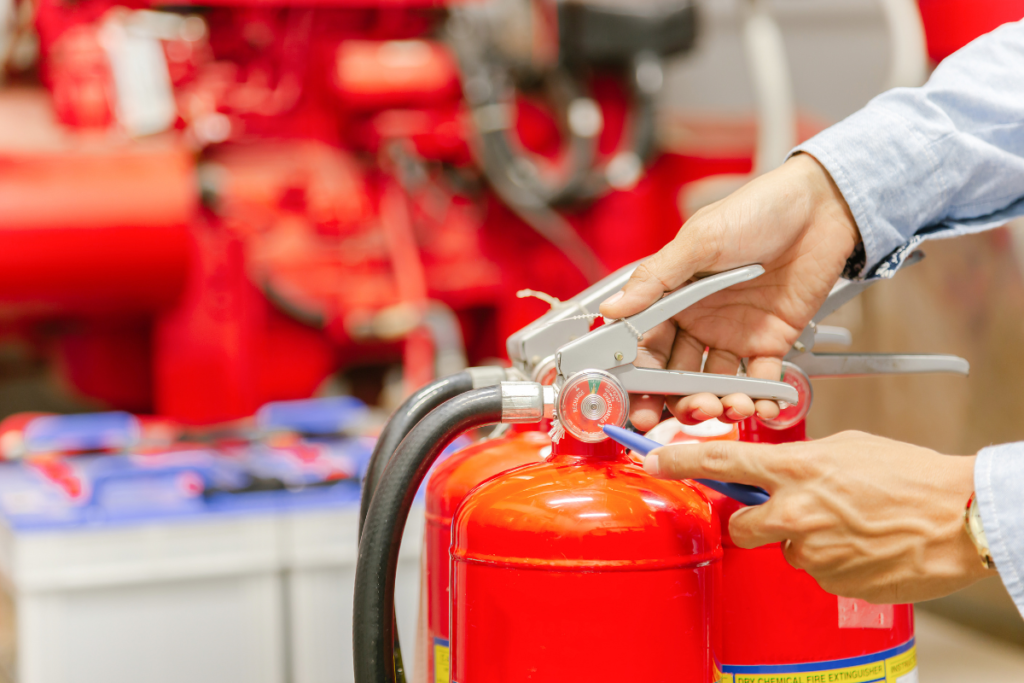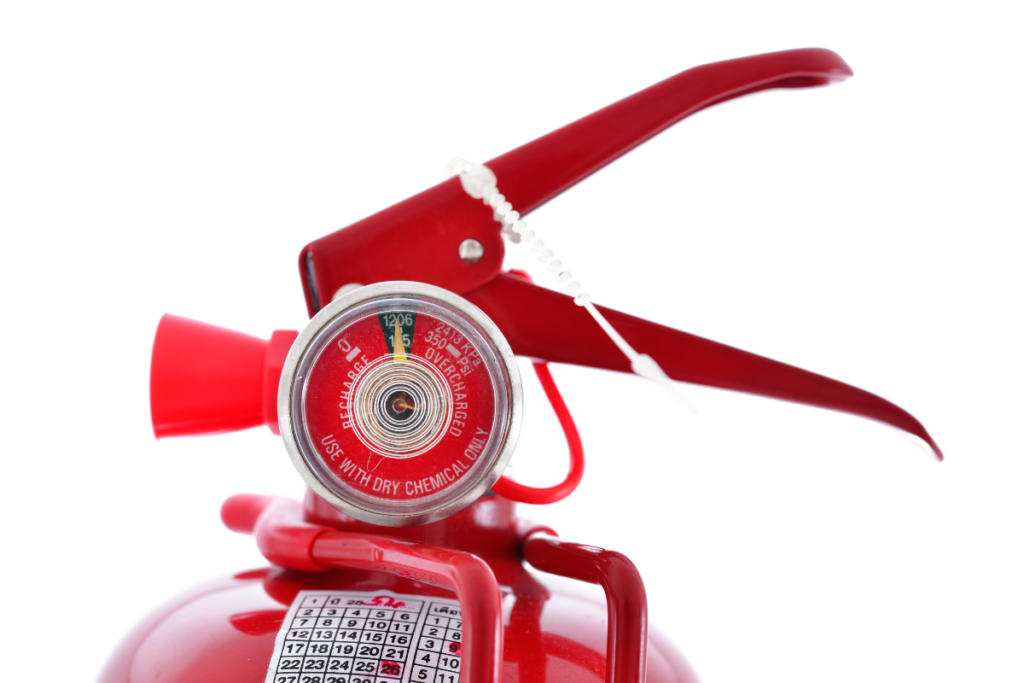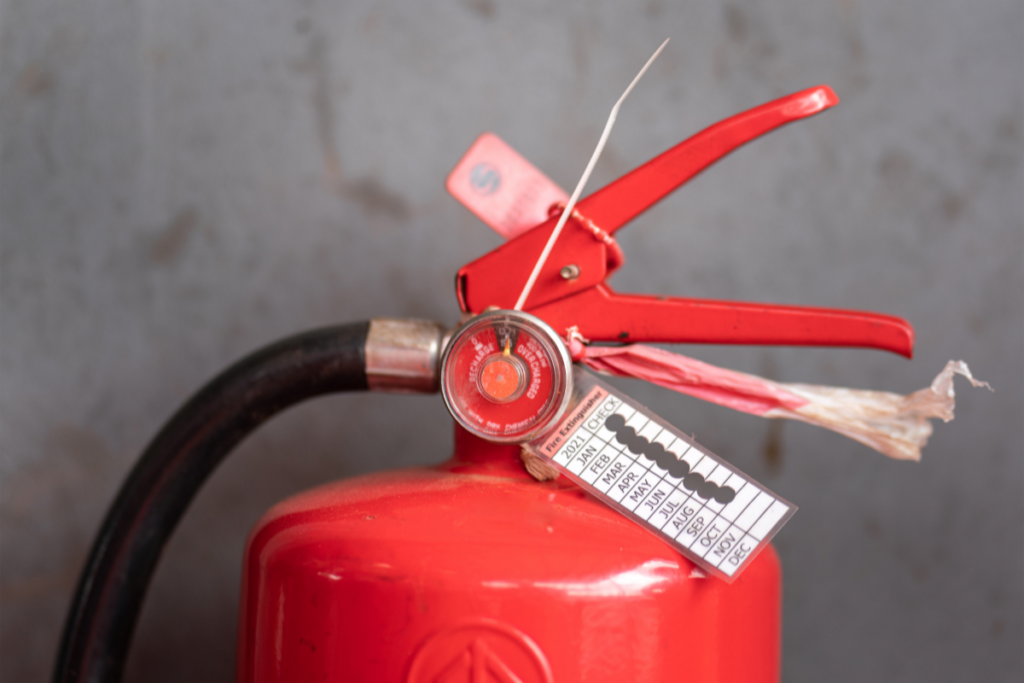Table of contents

Fire extinguishers are essential tools for preventing and controlling fires in the workplace. However, they are only effective if they are properly maintained and inspected regularly. Fire extinguisher inspections are vital for ensuring workplace safety and compliance with fire codes and standards. In this guide, we will explain what fire extinguisher inspections are, why they are necessary, who is responsible for them, how to perform them step-by-step, what common issues to look for, how to address them, and how to document and record them with Certainty Software.
What is a Fire Extinguisher Inspection?
A fire extinguisher inspection is a process of checking the condition and functionality of a fire extinguisher to ensure that it is ready for use in case of an emergency. Different types of inspections vary in frequency and scope, depending on the type and location of the fire extinguisher. The main types of inspections are:
- Monthly visual inspections: These are quick checks that can be performed by anyone familiar with the fire extinguisher. They involve looking for any signs of physical damage, proper pressure level, and accessibility of the fire extinguisher. They also involve verifying the presence and legibility of the inspection tag, which indicates the date and result of the last inspection.
- Annual physical inspections: These are more thorough checks that require a trained and qualified person to perform. They involve examining the hoses, nozzles, labels, seals, and other critical components of the fire extinguisher. They also involve testing and verifying the pressure, gauges, and triggers of the fire extinguisher. They also involve updating the inspection tag with the current date and result.
- Hydrostatic testing: This is a periodic test that involves filling the fire extinguisher with water or another non-compressible fluid and applying high pressure to check for leaks or cracks in the cylinder. This test is required every 5 or 12 years, depending on the type of fire extinguisher. It also involves replacing the inspection tag with a new one that indicates the date and result of the test.
Why Regular Fire Extinguisher Inspections are Necessary
By conducting routine inspections, you proactively verify that your fire extinguisher is in optimal working condition and poised to handle any potential fire hazard. These inspections not only ensure the immediate availability of a functional extinguisher but also serve as a preventive measure against malfunctions or failures that could lead to devastating consequences.
Moreover, regular inspections contribute to the longevity and efficiency of fire extinguishers. By identifying and addressing minor issues promptly, you can prevent them from escalating into major problems that may compromise the extinguisher’s effectiveness. This proactive approach saves you from unnecessary expenses and guarantees that your fire safety equipment remains in peak performance for an extended period.
In addition to the practical benefits, regular inspections are essential for meeting legal and regulatory requirements. Authorities such as OSHA (Occupational Safety and Health Administration), NFPA (National Fire Protection Association), and local fire departments set stringent guidelines for fire safety in the workplace. Failure to comply with these regulations not only exposes you to fines and penalties but also puts you at risk of legal liabilities.
Who is Responsible for Fire Extinguisher Inspections?
The responsibility for fire extinguisher inspections depends on several factors, such as the size and nature of the business, the number and type of fire extinguishers, and the availability of resources and expertise. Generally speaking, there are three main options for conducting fire extinguisher inspections:
- Outsourcing: Here, professionals in fire protection are hired to perform the inspections. This option is suitable for businesses that have a large number of fire extinguishers or lack the time or skills to perform the inspections themselves. The advantages of outsourcing include saving time and effort, ensuring quality and reliability, and accessing specialized equipment and knowledge. The disadvantages include higher costs, less control over scheduling and frequency, and potential communication or coordination issues.
- In-house: Designated employees who have received adequate training and certification would perform the fire extinguisher inspections. This option is suitable for businesses that have a small number of fire extinguishers or prefer to have more control over the inspection process. The advantages of in-house include lower costs, more flexibility and convenience, and greater involvement and awareness of employees. The disadvantages include requiring more time and resources, ensuring proper training and qualification of employees, and maintaining adequate tools and supplies.
- Hybrid: This involves combining outsourcing and in-house methods to perform different types of inspections. For example, a business could outsource annual inspections and hydrostatic testing while performing monthly visual inspections in-house. This option is suitable for businesses that want to balance the benefits and drawbacks of both methods. The advantages of hybrid include optimizing costs and quality, customizing inspection plans according to needs and preferences, and leveraging external and internal expertise. The disadvantages include requiring more coordination and communication between parties, ensuring consistency and compatibility between methods, and managing multiple contracts and agreements.
How to Perform a Monthly Fire Extinguisher Inspection Step-by-Step
Now that we have covered the basics of fire extinguisher inspections, let’s dive into the details of how to perform them. As we mentioned earlier, there are different types of inspections that vary in frequency and scope, depending on the type and location of the fire extinguisher. In this section, we will focus on the most common and simple type of inspection: the monthly visual inspection. This is a quick check that can be performed by anyone who is familiar with the fire extinguisher. It involves looking for any signs of physical damage, proper pressure level, and accessibility of the fire extinguisher. It also involves verifying the presence and legibility of the inspection tag, which indicates the date and result of the last inspection.
The following steps outline how to perform a monthly visual inspection of a fire extinguisher:
1. Pre-inspection preparation
Gather the necessary tools and resources for the inspection, such as a Fire Extinguisher Inspection Checklist, a flashlight (if needed), gloves (if needed), etc.

30+ Audit and inspection checklists free for download.
2. Visual inspection process
Locate the fire extinguisher and check the following aspects:
- Physical damage: Look for any dents, cracks, rust, corrosion, or other signs of damage on the cylinder, hose, nozzle, valve, handle, or other parts of the fire extinguisher. If any damage is found, mark the fire extinguisher as defective and report it for repair or replacement.
- Proper pressure: Check the pressure gauge or indicator on the fire extinguisher to ensure that it is in the green or full zone. If the pressure is too low or too high, mark the fire extinguisher as defective and report it for recharging or servicing.

- Accessibility: Ensure that the fire extinguisher is easily visible and accessible in its designated location. It should not be blocked, hidden, or locked by any objects or obstacles. It should also have a clear and legible sign or label indicating its type and location.
- Inspection tag: Ensure that the fire extinguisher has a valid and up-to-date inspection tag attached to it. The tag should indicate the date and result of the last inspection. It should also be signed by the person who performed the inspection.

3. Physical inspection process
Remove the fire extinguisher from its mount or bracket and check the following aspects:
- Hoses: Inspect the hoses for any cracks, holes, leaks, or kinks that could impair the flow of the extinguishing agent. If any defects are found, mark the fire extinguisher as defective and report it for repair or replacement.
- Nozzles: Inspect the nozzles for any clogs, dirt, or debris that could obstruct the spray of the extinguishing agent. If any obstructions are found, clean them with a soft cloth or brush. Do not use any sharp objects or chemicals to clean the nozzles.
- Labels: Inspect the labels for any fading, peeling, tearing, or illegibility that could prevent users from reading the operating instructions or identifying the type of fire extinguisher. If any issues are found, mark the fire extinguisher as defective and report it for relabeling or replacement.
- Seals: Inspect the seals for any tampering, breaking, or missing that could indicate that the fire extinguisher has been used or compromised. If any issues are found, mark the fire extinguisher as defective and report it for resealing or servicing.
4. Testing and verification
Perform the following tests to verify the functionality of the fire extinguisher:
- Pressure check: Lift the fire extinguisher and feel its weight. It should feel full and heavy. If it feels light or empty, mark it as defective and report it for recharging.
- Gauge test: Tap the pressure gauge lightly with your finger. It should move slightly and return to its original position. If it does not move or stays stuck in one position, mark it as defective and report it for servicing.
- Trigger test: Squeeze the trigger lightly to check if it moves smoothly and springs back when released. Do not squeeze too hard or release any of the extinguishing agents. If the trigger does not move or spring back properly, mark it as defective and report it for repair or replacement.
Common Issues to Look for During a Fire Extinguisher Inspection
When conducting a fire extinguisher inspection, it’s crucial to be aware of common issues that can compromise the performance and safety of this vital firefighting equipment. By promptly addressing these issues, you can ensure that your fire extinguisher remains in optimal condition and ready for action when it matters most. The following are some of the most common issues that can affect the performance and safety of a fire extinguisher:
Damaged or worn-out parts
Over time, exposure to heat, moisture, dust, chemicals, or physical impact can cause damage or wear-and-tear to various parts of the fire extinguisher, such as hoses, nozzles, valves, handles, etc. These parts should be inspected regularly and replaced if necessary to ensure proper functionality and prevent leaks or malfunctions.
Corroded or expired extinguisher agents
Depending on the type of fire extinguisher, different types of extinguishing agents are used, such as water, foam, powder, carbon dioxide (CO2), etc. These agents can degrade over time due to chemical reactions, temperature changes, moisture absorption, or contamination. This can reduce their effectiveness and increase their toxicity. These agents should be checked regularly and refilled or replaced if necessary to ensure optimal performance and safety.
Missing or illegible labels
Labels are important for providing users with essential information about how to use and maintain a fire extinguisher. They also help identify the type of fire extinguisher and its suitability for different classes of fires (A, B, C, D, K). Labels can become missing or illegible due to fading, peeling, tearing, vandalism, etc. This can create confusion and risk for users who may not know how to operate a fire extinguisher properly or use it on an inappropriate type of fire. Labels should be checked regularly and relabeled or replaced if necessary to ensure clarity and accuracy.
Obstructed access or improper storage
Fire extinguishers should be easily visible and accessible in their designated locations. They should not be blocked, hidden, or locked by any objects or obstacles that could prevent users from reaching them quickly in case of an emergency. They should also be stored in appropriate conditions that protect them from extreme temperatures (hot or cold), direct sunlight (UV rays), moisture (rain), dust, chemicals (corrosives), etc. These factors can damage or degrade the fire extinguisher and its components over time. Fire extinguishers should be checked regularly and relocated or replaced if necessary to ensure optimal accessibility and storage.
Addressing Issues Encountered During Inspections
If any issues are encountered during a fire extinguisher inspection, they should be addressed promptly and properly to ensure the fire extinguisher is restored to its full functionality and safety. Depending on the type and severity of the issue, different actions may be required, such as:
- Minor repairs and routine maintenance: Some issues can be fixed easily and quickly by performing minor repairs or routine maintenance on the fire extinguisher. For example, cleaning the nozzle, replacing the seal, refilling the pressure, etc. These actions can be performed by anyone who is trained and qualified to do so, either in-house or outsourced.
- Refilling or replacing extinguishing agents: Some issues may require refilling or replacing the extinguishing agent in the fire extinguisher. For example, if the agent is low, expired, corroded, or contaminated. These actions should be performed by a professional fire protection company or contractor who has the proper equipment and expertise to do so safely and correctly.
- Major repairs or replacements: Some issues may require major repairs or replacements of the fire extinguisher or its components. For example, if the cylinder is cracked, the valve is broken, the gauge is faulty, etc. These actions should also be performed by a professional fire protection company or contractor who can ensure the quality and reliability of the service.
Documentation and Record-Keeping With Certainty Software
Documentation and record-keeping are essential aspects of fire extinguisher inspections. They provide evidence of compliance with fire codes and standards and a history of inspection results and actions taken. They also help identify trends and patterns of issues and performance over time. Documentation and record-keeping can be done manually using paper forms or logs, or digitally using software applications or systems.
Certainty Software is a leading software solution for fire extinguisher inspections and other types of workplace safety inspections. We offer several features and benefits that can streamline and enhance the documentation and record-keeping process, such as:
- Customizable inspection forms: Users can create and customize their own inspection forms according to their specific needs and preferences. You can then choose from a variety of templates or create your own from scratch. There is also the option of adding photos, videos, signatures, comments, ratings, etc. to their forms for more detail and clarity.
- Digital record storage: We store all inspection records digitally in a secure cloud-based platform that can be accessed anytime and anywhere by authorized users. Users can also export or print their records as PDFs, Excel, or Word files for backup or sharing purposes.
- Automated reminders: Certainty Software sends automated reminders to users to notify them of upcoming or overdue inspections. This helps users stay on track with their inspection schedules and avoid missing any deadlines or requirements.
- Reporting capabilities: Users of Certainty Software are provided with powerful reporting capabilities that allow them to analyze and visualize their inspection data in various ways. Reports can be generated based on different criteria, such as location, date, frequency, issue type, action status, etc. Furthermore, you can also use dashboards, charts, graphs, maps, etc. to display your data in an interactive and engaging way.
You might also be interested in:



